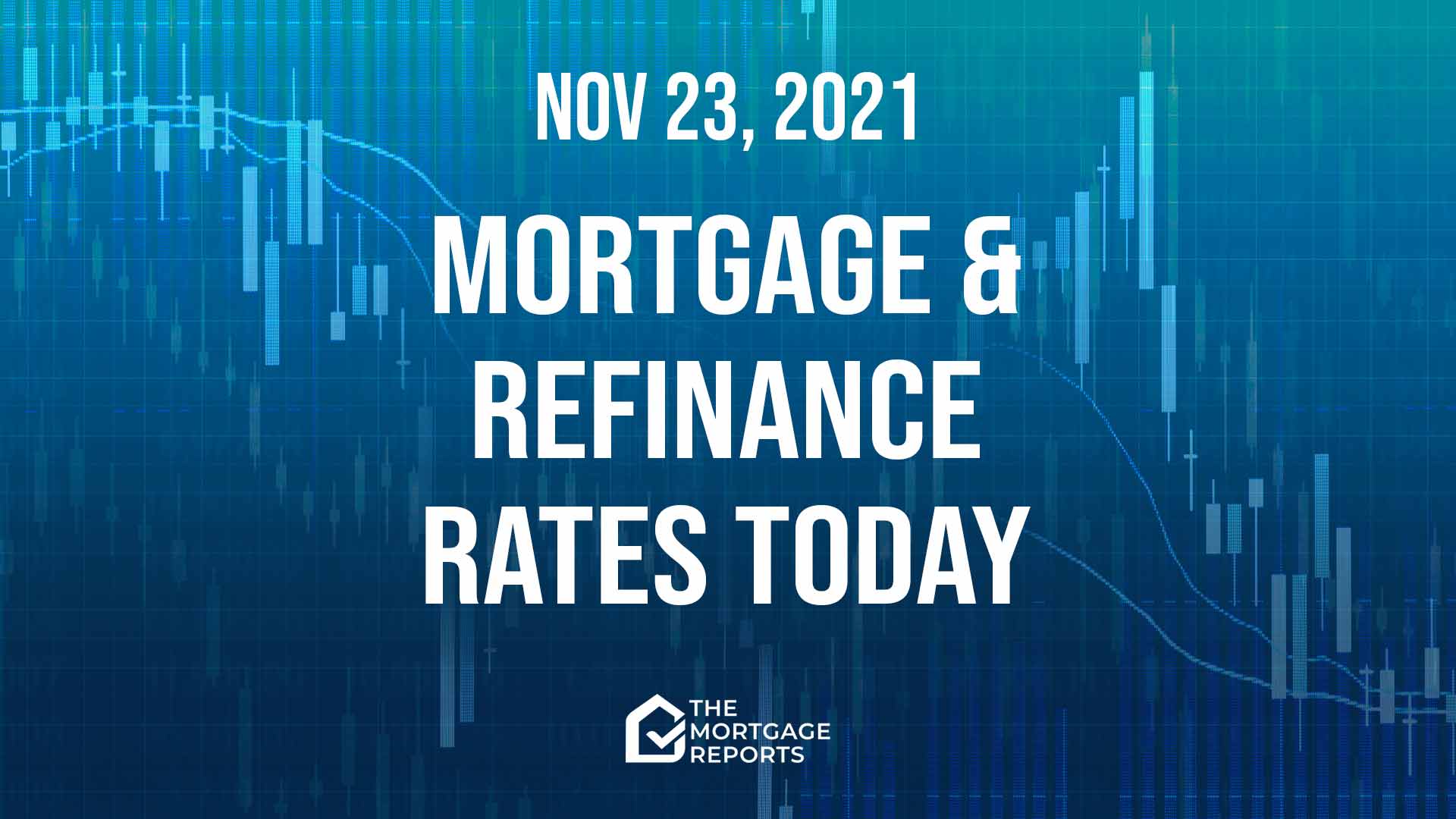
Today’s mortgage and refinance rates
Average mortgage rates bounced higher yesterday, wiping out most of last week’s gains. Still, these rates remain extraordinarily low by historical standards.
First thing, it was looking as if mortgage rates today might rise again. But that could change as the hours pass.
Find your lowest rate. Start here (Nov 23rd, 2021)Current mortgage and refinance rates
| Program | Mortgage Rate | APR* | Change |
|---|---|---|---|
| Conventional 30 year fixed | |||
| Conventional 30 year fixed | 3.34% | 3.36% | +0.08% |
| Conventional 15 year fixed | |||
| Conventional 15 year fixed | 2.746% | 2.778% | +0.08% |
| Conventional 20 year fixed | |||
| Conventional 20 year fixed | 3.224% | 3.258% | +0.12% |
| Conventional 10 year fixed | |||
| Conventional 10 year fixed | 2.729% | 2.789% | +0.07% |
| 30 year fixed FHA | |||
| 30 year fixed FHA | 3.401% | 4.167% | +0.11% |
| 15 year fixed FHA | |||
| 15 year fixed FHA | 2.713% | 3.359% | +0.1% |
| 5/1 ARM FHA | |||
| 5/1 ARM FHA | 2.626% | 3.217% | +0.09% |
| 30 year fixed VA | |||
| 30 year fixed VA | 3.261% | 3.457% | +0.4% |
| 15 year fixed VA | |||
| 15 year fixed VA | 2.858% | 3.201% | +0.11% |
| 5/1 ARM VA | |||
| 5/1 ARM VA | 2.56% | 2.4% | +0.03% |
| Rates are provided by our partner network, and may not reflect the market. Your rate might be different. Click here for a personalized rate quote. See our rate assumptions here. | |||
Should you lock a mortgage rate today?
I’m still expecting mortgage rates to rise generally. But I am aware that a new wave of COVID-19 might cause them to fall over the winter. We’ll be keeping an eye on that.
Still, for now, my personal rate lock recommendations remain:
- LOCK if closing in 7 days
- LOCK if closing in 15 days
- LOCK if closing in 30 days
- LOCK if closing in 45 days
- LOCK if closing in 60 days
>Related: 7 Tips to get the best refinance rate
Market data affecting today’s mortgage rates
Here’s a snapshot of the state of play this morning at about 9:50 a.m. (ET). The data, compared with roughly the same time yesterday, were:
- The yield on 10-year Treasury notes climbed to 1.65% from 1.58%. (Bad for mortgage rates.) More than any other market, mortgage rates normally tend to follow these particular Treasury bond yields
- Major stock indexes were mostly higher soon after opening. (Bad for mortgage rates.) When investors are buying shares they’re often selling bonds, which pushes prices of those down and increases yields and mortgage rates. The opposite may happen when indexes are lower. But this is an imperfect relationship
- Oil prices rose to $78.55 from $76.13 a barrel. (Bad for mortgage rates*.) Energy prices play a large role in creating inflation and also point to future economic activity.
- Gold prices fell to $1,790 from $1,818 an ounce. (Bad for mortgage rates*.) In general, it is better for rates when gold rises, and worse when gold falls. Gold tends to rise when investors worry about the economy. And worried investors tend to push rates lower
- CNN Business Fear & Greed index — dropped to 60 from 71 out of 100. (Good for mortgage rates.) “Greedy” investors push bond prices down (and interest rates up) as they leave the bond market and move into stocks, while “fearful” investors do the opposite. So lower readings are better than higher ones
Caveats about markets and rates
Before the pandemic and the Federal Reserve’s interventions in the mortgage market, you could look at the above figures and make a pretty good guess about what would happen to mortgage rates that day. But that’s no longer the case. We still make daily calls. And are usually right. But our record for accuracy won’t achieve their former high levels until things settle down.
So use markets only as a rough guide. Because they have to be exceptionally strong or weak to rely on them. But, with that caveat, mortgage rates today look likely to rise. But be aware that “intraday swings” (when rates change direction during the day) are a common feature right now.
Find your lowest rate. Start here (Nov 23rd, 2021)Important notes on today’s mortgage rates
Here are some things you need to know:
- Typically, mortgage rates go up when the economy’s doing well and down when it’s in trouble. But there are exceptions. Read ‘How mortgage rates are determined and why you should care
- Only “top-tier” borrowers (with stellar credit scores, big down payments and very healthy finances) get the ultralow mortgage rates you’ll see advertised
- Lenders vary. Yours may or may not follow the crowd when it comes to daily rate movements — though they all usually follow the wider trend over time
- When daily rate changes are small, some lenders will adjust closing costs and leave their rate cards the same
- Refinance rates are typically close to those for purchases. And a recent regulatory change has narrowed a gap that previously existed
So a lot is going on here. And nobody can claim to know with certainty what’s going to happen to mortgage rates in coming hours, days, weeks or months.
Are mortgage and refinance rates rising or falling?
Why was there such a sharp rise yesterday? Much of it was down to President Joe Biden reappointing (well, announcing that he would be nominating) Jerome Powell for a second term as Federal Reserve chair.
The Financial Times greeted the news with the headline, “Biden plays it safe with continuity at the Fed.” And investors had been worried that a replacement might have been less helpful to banks and others over the Fed’s regulatory duties.
So American Banker magazine said yesterday:
President Biden’s announcement that he is reappointing Jerome Powell as chair of the Federal Reserve suggests that not much will change regarding supervision, capital requirements and approval of merger applications.
— American Banker, “What Powell’s Fed renomination means for banks,” Nov. 22, 2021
Much of last Friday’s appreciable fall in mortgage rates was down to concerns that the president might not nominate Powell for the job. So it wasn’t much of a surprise that those rates bounced back yesterday, returning them to roughly where they were on Thursday evening.
Tomorrow could move mortgage rates
There’s a small avalanche of market-sensitive information due out tomorrow. That includes the minutes of the last meeting of the Federal Reserve’s monetary policy body, the Federal Open Market Committee (FOMC). Investors always closely study those for hints about the Fed’s thinking.
Economic reports tomorrow include those for core inflation, personal income, real disposable income, consumer spending the consumer sentiment index. And any of those could move mortgage rates if it contains unexpectedly good or bad data. Typically, those rates move up on good news and down on bad.
However, tomorrow is also the day before the Thanksgiving holiday. And (much as they like to portray themselves differently) investors, analysts and traders are people, too. So it may well be that many of them will be too distracted by their own plans to take much notice.
What does that mean? Tomorrow’s unpredictable.
Pandemic uncertainty
Yesterday, I wrote about the possibility of a new wave of COVID-19 infections bringing lower mortgage rates over the winter. Don’t get too excited because it’s way too soon even to guesstimate the potential size of such a wave (if one materializes) or the economic harm it might do.
But, if you missed yesterday’s article, you can catch up here.
You can also read last Saturday’s weekend edition for more general background.
Recently
Over much of 2020, the overall trend for mortgage rates was clearly downward. And a new, weekly all-time low was set on 16 occasions last year, according to Freddie Mac.
The most recent weekly record low occurred on Jan. 7, when it stood at 2.65% for 30-year fixed-rate mortgages.
Since then, the picture has been mixed with extended periods of rises and falls. Unfortunately, since September, the rises have grown more pronounced, though not consistently so.
Freddie’s Nov. 17 report puts that weekly average for 30-year, fixed-rate mortgages at 3.1% (with 0.7 fees and points), up from the previous week’s 2.98%.
Expert mortgage rate forecasts — updated today
Looking further ahead, Fannie Mae, Freddie Mac and the Mortgage Bankers Association (MBA) each has a team of economists dedicated to monitoring and forecasting what will happen to the economy, the housing sector and mortgage rates.
And here are their current rate forecasts for the remaining, current quarter of 2021 (Q4/21) and the first three quarters of 2022 (Q1/22, Q2/22 and Q3/22).
The numbers in the table below are for 30-year, fixed-rate mortgages. Fannie’s were published on Nov. 18 and the MBA’s on Nov. 22.
Freddie’s were released on Oct. 15. It now updates its forecasts only quarterly. So we may not get another from it until January.
| Forecaster | Q4/21 | Q1/22 | Q2/22 | Q3/22 |
| Fannie Mae | 3.1% | 3.2% | 3.3% | 3.3% |
| Freddie Mac | 3.2% | 3.4% | 3.5% | 3.6% |
| MBA | 3.1% | 3.3% | 3.5% | 3.7% |
However, given so many unknowables, the whole current crop of forecasts may be even more speculative than usual.
All these forecasts expect at least modestly higher mortgage rates fairly soon.
Find your lowest rate today
Some lenders have been spooked by the pandemic. And they’re restricting their offerings to just the most vanilla-flavored mortgages and refinances.
But others remain brave. And you can still probably find the cash-out refinance, investment mortgage or jumbo loan you want. You just have to shop around more widely.
But, of course, you should be comparison shopping widely, no matter what sort of mortgage you want. As federal regulator the Consumer Financial Protection Bureau says:
Shopping around for your mortgage has the potential to lead to real savings. It may not sound like much, but saving even a quarter of a point in interest on your mortgage saves you thousands of dollars over the life of your loan.
Verify your new rate (Nov 23rd, 2021)Mortgage rate methodology



